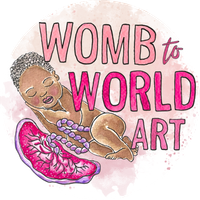Delayed Optimal Cord Clamping A3 PDF Handout
An A3 antenatal education PDF download about why it's so important to delay clamping the umbilical cord with a licence for birth workers to share as printed materials with clients and as teaching tools in childbirth education classes.
"All mammal babies are connected to their mother in the womb by the umbilical cord, but the baby's blood is kept separate to the mother's by the placenta. When babies are born, the placenta and umbilical cord are still full of baby's blood - up to 33% in term babies and up to 50% in pre-term babies. Animal mothers have the instinctive knowledge to wait until all the blood has transferred to their baby, and they cut the cord after the placenta has been born. Since ancient times, humans followed this instinct too, but 'early cord clamping' started in the 20th century - and despite recommendations from the World Health Organisation - the cord is often still routinely clamped within seconds after birth, also known as immediate cord clamping."
A great support alongside hypnobirthing and educating yourself on physiological birth, or for doulas to include in client materials or use as a teaching tool.
________________________
Copyright and Limited Use Commercial License
The limited use commercial license that comes with this download means that birth workers, doulas, hypnobirthing teachers, prenatal yoga teachers, antenatal educators and midwives can print to share and use with pregnant women, birth partners and clients. By buying this download you are agreeing to the following terms:
The license means you - as an individual - can:
- Print the downloads on paper or card at the size specified
- Give the printouts as handouts to your clients, or use as teaching tools or posters for your business
- You may use use a professional print service or print at home
- Add the images to a Powerpoint presentation to use with clients in person or remotely, as long as the presentation file itself isn't shared digitally
- Share the content using photos or videos of your printed materials on social media
The license DOES NOT allow you to:
- Print the images for any other reason than above or on any other material e.g. on a notebook or mug to give away
- Use the images as part of a product you will sell
- Share the digital files with anyone by email or another method
- Add the digital files to your website or use on social media
- Edit the images or remove my brand name
- Share with other professionals in your organisation
Thank you for respecting the time that has gone into creating this artwork. If you have any questions about the license agreement, please contact me.
Copyright
These handmade images, text and files are copyright of Hannah Thomas of Womb to World Art and sole copyright is retained by them.
Disclaimer: Please note my images are stylised visual representations, and the information is accurate to the best of my knowledge, but I am not a medical professional and therefore there may be words or parts of the drawings that aren't 100% anatomically and medically accurate. My materials are not intended to replace any medical caregiver advice.







